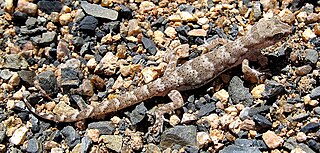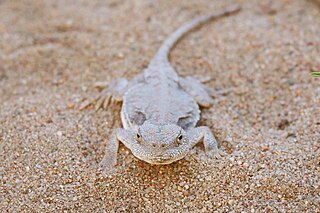
Alsophylax is a genus of small species of geckos, endemic to Central Asia, commonly known as even-fingered geckos. The snout-vent length of these geckos is normally no more than 4 cm (1.6 in). Little is known of their ecology or reproductive habits.

Eremias is a genus of lizards in the family Lacertidae, the wall lizards. They are native to Asia and southeastern Europe, where they live in desert and steppe regions.

The thorny devil, also known commonly as the mountain devil, thorny lizard, thorny dragon, and moloch, is a species of lizard in the family Agamidae. The species is endemic to Australia. It is the sole species in the genus Moloch. It grows up to 21 cm (8.3 in) in total length, with females generally larger than males.

Phrynocephalus mystaceus, also known as the secret toadhead agama and toad-headed agama, is a species of agamid lizard. It is found in southern Russia, Kazakhstan, and northwestern China (Xinjiang) and southward to northern Iran, Afghanistan, Turkmenistan, Tajikistan, Kyrgyzstan, and Uzbekistan.

Alexander Strauch was a Russian naturalist, most notably a herpetologist.

Phrynocephalus persicus, commonly known as the Persian toad-headed agama, is a small diurnal desert lizard of the family Agamidae. It is the westernmost representative of the Central Asian genus of toad-headed agamas Phrynocephalus and is only known from deserts and semideserts of Iran and possibly Azerbaijan.

Phrynocephalus versicolor, the Tuvan toad-headed agama, is a species of agamid lizard found in desert areas of China and Mongolia. It was first described by the Russian herpetologist Alexander Strauch, director of the Zoological Museum at the Imperial Academy of Sciences at St. Petersburg.

Phrynocephalus horvathi is a small diurnal desert lizard in the family Agamidae. It is endemic to the valley of the Aras River and considered Critically Endangered.
Phrynocephalus clarkorum, also known commonly as the Afghan toad-headed agama and Clark's toad-headed agama, is a species of lizard in the family Agamidae. The species is native to parts of Central and South Asia.
Phrynocephalus forsythii, also known commonly as Forsyth's toadhead agama and Forsyth's toad-headed lizard, is a species of lizard in the family Agamidae. The species is endemic to China.

Phrynocephalus guttatus, also known commonly as the spotted toadhead agama, the Saissan toad-headed agama, the Central Asian toadhead agama, and Salensky's toadhead agama, is a species of lizard in the family Agamidae. The species is native to southeastern Europe and western Asia. There are five recognized subspecies.

Phrynocephalus helioscopus, the sunwatcher toadhead agama, Fergana toad-headed agama, or sunwatcher, is a species of agamid lizard found in Kazakhstan, S Russia, Turkmenistan, Uzbekistan, Kyrgyzstan, Tajikistan, Turkey, Iraq, China, Mongolia, and Iran.

Phrynocephalus maculatus, the blacktail toadhead agama or spotted toad-headed agama, is a species of agamid lizard in Iran, Turkmenistan, Syria, Jordan, Iraq, Afghanistan, Pakistan, Saudi Arabia, Oman, United Arab Emirates, and Kuwait.

Przewalski's toadhead agama, also known as Tsarewsky's toadhead agama, or Steindachner's toadhead agama, is a species of agamid lizard found in China and Mongolia. This species was named after Nikolay Przhevalsky, a Russian Imperial geographer and explorer of Central and East Asia.

Phrynocephalus vlangalii, also known as the Qinghai toad-headed agama, the Ching Hai toadhead agama, the Pylzow's toadhead agama, or gecko toadhead agama, is a species of viviparous agamid lizard endemic to the Tibetan Plateau in China. This lizard lives in burrows at high elevations of 2,000 to 4,600 meters. It is also known for its aggression, especially between females during mating season since females usually only have one mate. P. vlangalii curls its tail and shows a patch on its underbelly as defense displays against conspecifics. This lizard also has a variety of gut microbiota that help perform metabolic and biological functions depending on the altitude at which the lizard lives.
Phrynocephalus meridionalis, the sunwatcher toadhead agama or Fergana toad-headed agama, is a species of agamid lizard found in Uzbekistan.














